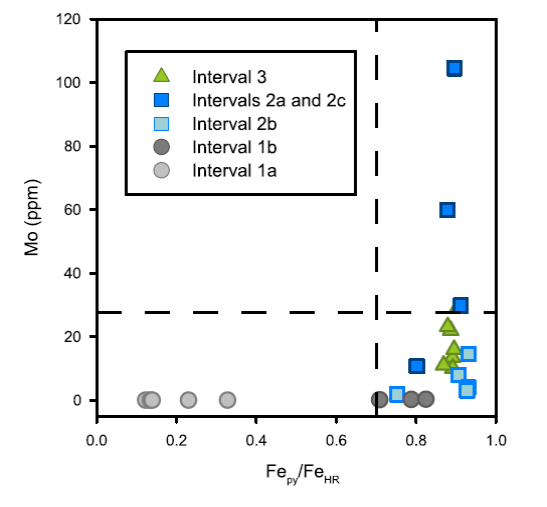Reports: ND853845-ND8: The Role of Sea Level Change in the Spatial and Temporal Distribution of Organic Carbon Accumulation and Bottom Water Redox Conditions in the Cretaceous Niobrara Sea
Nathan D. Sheldon, PhD, University of Michigan
ACS Project 53845-ND8 entitled “The role of sea level change in the spatial and temporal distribution of organic carbon accumulation and bottom water redox conditions in the Cretaceous Niobrara Sea” is focused on determining whether the extended period of organic matter burial that characterizes Oceanic Anoxic Event 3 (OAE 3) was triggered by enhanced productivity or by enhanced preservation. The Niobrara Formation is currently being fracked for hydrocarbons, so understanding the mechanism of carbon burial during its deposition is potentially of value both for producing hydrocarbons in other parts of the basin as well as for selecting among other potential targets for resource extraction. In the first year of the project, we reported on data from a number of cores (Fig. 1), showing enhanced carbon burial during OAE 3 and determined that there was no evidence for enhanced productivity, but that there was evidence for a shift in bottom water redox at the onset of interval 2A (Fig. 1). Thus, we concluded that enhanced preservation was the cause of the shift to organic carbon accumulation (Tessin et al., 2015, Paleoceanography).
|
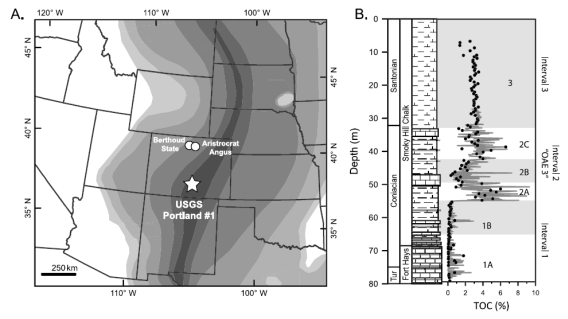
With the second year of the proposal and the ongoing work, we are examining metal and nutrient records to understand how this extended period of organic carbon burial was maintained. In particular, work has shifted toward looking at trace metals such as Cd and Mo, which are strongly associated with nutrient burial and bottom water sulfide, respectively, and on the role of Fe in nutrient burial and recycling. Figure 2 from Tessin et al. (2016, EPSL) shows the results of sequential extraction of Fe into different reactivity/minerals classes. While the gross amount of Fe is unchanged (Fig. 2b), there is a significant shift in the amount of Fe hosted by pyrite or other sulfide minerals (Fig. 2d)
|
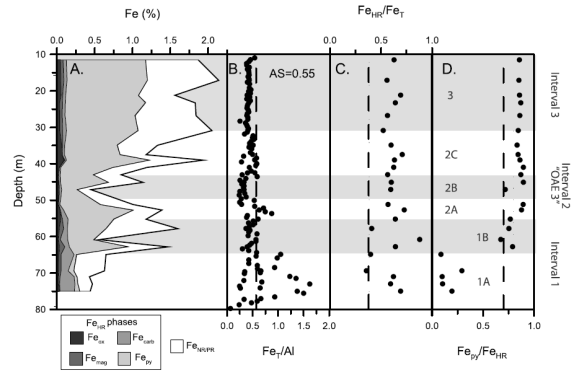
This shifted in Fe behavior was accompanied by increase Mo and Re accumulation (Fig. 3), which are indicative of anoxic and euxinic conditions, and by Cd and Zn accumulations, which are indicative of enhanced nutrient burial.
|
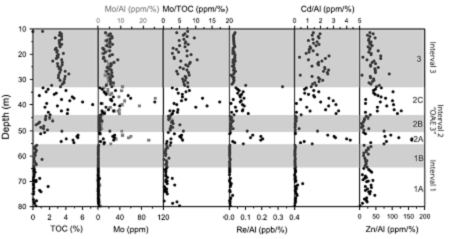
This latter point is confirmed when phosphorus is considered. Prior to the onset of significant organic burial (Interval 1, Fig. 4), the carbon to phosphorus ratio was much lower than the Redfield ratio of 106:1, which indicated significant oxidation and degradation of organic carbon, resulting low burial efficient. After the onset of euxinic/anoxic conditions, the TOC:P ratios shifts up to the Redfield ratio or even in excess of the Redfield ratio, which indicates much more efficient burial of organic carbon.
|
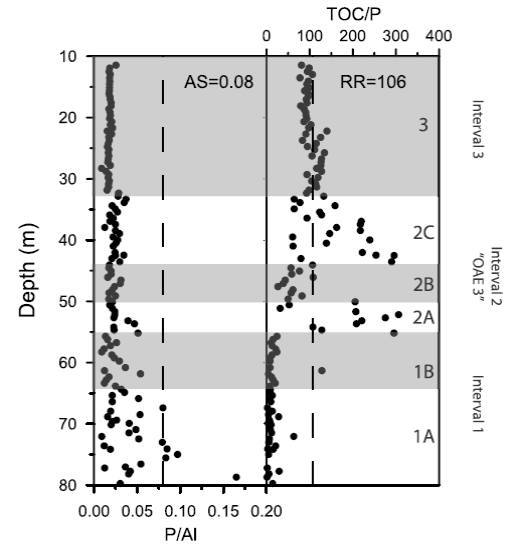
The final consideration is what role, if any, the onset of euxinic conditions may have played. This was examined by comparing two different indicators of euxinia, the ratio of Fe in pyrite to the total amount of highly reactive Fe versus the Mo content. During OAE3 and the concomitant increase in organic carbon burial during Intervals 2 and 3, whereas there’s little change in Fe behavior, Mo fluctuates between indicating anoxic and euxinic conditions. We take this to mean that Fe was limited during the period of enhanced organic carbon burial because of burial and co-precipitation with P. That is, much of the extended period of burial was also fueled by nutrient recycling the Fe-P cycle in the bottom waters and upper part of the sediment column. This idea has significant implications for how we understand Fe speciation data, which have been widely applied throughout the geologic record. Thus, to understand the mechanisms of carbon burial elsewhere, future workers should apply a similar approach that involves multiple proxies for both nutrient state and anoxia versus euxinia.
|
